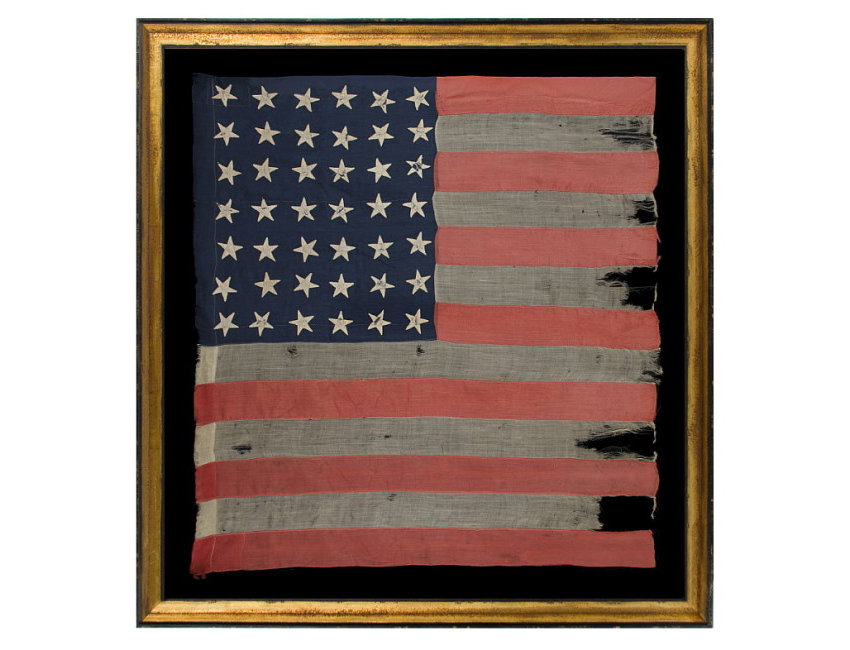|
42 STARS, AN UNOFFICIAL STAR COUNT, 1889-1890, POSSIBLY A U.S. CAVALRY STANDARD, INTERESTING TALL AND NARROW FORMAT, WASHINGTON STATEHOOD:
|
|

|
Description: |
|
| 42 star American national flag, made in the 1889-90 period, probably for U.S. Army application as a cavalry standard. Smaller than a infantry battle flag, but in a square profile that bears some similarities, the basic form is distinctly military with a vertically-oriented, tall and narrow canton. The unfurled size is close to that of Civil War regulations for U.S. Cavalry colors. And unlike most wool flags that have survived from the 19th century, the pattern of wear and fabric loss in this flag represent extended use rather than moth damage. While the flag has no specific history, the above facts suggest that the flag may have been carried as a Indian War-era, U.S. cavalry battle flag.
During the Civil War and prior, most battle flags were made of silk and had gilt-painted stars. After the war, the choice of materials didn't change a great deal, but with the end of Reconstruction in 1876 came the beginning of a transitional era for the construction of flags for military ground forces. Many battle colors produced after that date are wool with appliqu�d cotton stars, like this flag.
The 42 star flag is interesting from a historical perspective, both because 42 was never an official star count, and because 42 star flags were only produced for about 8 months (November, 1889 � July 4th, 1890). The flag represents the addition of the Dakotas, Montana and Washington State, between November 2nd and November 11th, 1889. The 42nd state was officially Washington, but the four states gained their statehood only nine days apart, and flag makers added four stars, accordingly, to the 38 star flag that was previously official.
After 1818, star counts became official on the 4th of July each year. A new star was therefore officially added on Independence Day for every state that had been added over the preceding �flag year�. Flag makers, however, did not wait for July 4th and official star counts. Flag making was a competitive industry, and no one wanted to be making 38 star flags, for example, when their competitors were making 42 star flags and there were 42 states. Idaho received statehood on July 3rd, 1890, taking the star count to 43 just one day before 42 would have become the official number. This fact makes 42 star flags an interesting part of our heritage and a classic display of American capitalism.
I have seen it at least one other military flag in this star count. I have never seen a square battle colors in the 42 star count, however, and I believe it to be a unique form in American flag collecting.
In addition to the rarity of the flag, note how the placement of the stars, which point in various directions on their vertical axis, adds an interesting folk quality. Together the wear, star positioning, color and patina result in a very attractive, 19th century flag.
Construction: The stripes and canton of the flag are made of wool bunting that has been joined with treadle stitching. The stars are made of cotton and double-appliqu�d (applied to both sides) of the navy blue canton with a lineal treadle stitch. An open sleeve was created at the hoist end by turning over the stripes and canton onto themselves and finishing with a treadle-stitch.
Mounting: The flag is in the process of being mounted. Fabric of similar coloration was placed behind the red stripes and blue canton to mask losses. The white stripes were not backed, so as to show age and use. The flag will then be stitched to 100% organze for support on every seam and throughout the star field. The flag will then be hand-sewn to a background of 100% cotton, black in color, which was washed to reduce excess dye. An acid-free agent was added to the wash to further set the dye, which was heat-treated for the same purpose. The mount will then be placed in a black-painted, hand-gilded and distressed Italian molding. The glazing will be U.V. protective acrylic. |
| Inventory Number: |
|
|
|
Dealer |
Jeff R. Bridgman American Antiques, llc |
| Contact |
Jeff Bridgman |
Phone: (717) 502-1281 |
|
| Period: |
19th Century (1801-1900) |
|
| Date: |
1889-1890 |
|
| Origin: |
|
|
| Condition: |
There is moderate to significant fabric loss throughout, particularly at the fly end and along the top. Almost half of the top stripe is absent, and this damage continues across the top edge of the canton. There is even significant wear on the stars, which is indicative of long-term heavy use. Many of my clients prefer early flags to show their age in an attractive manner. |
|
| Measurements: |
Frame: Approx: 79" x 73.5" Flag: 69" x 63.5" |
|
| Inventory |
Other Inventory by this Dealer |
|
| Web-site: |
http://www.jeffbridgman.com |
|
| Price: |
SOLD |
|
| E-mail: |
Inquire
|
|
Click thumbnail
to view larger
|
Views: 2478 |
|
|
|
